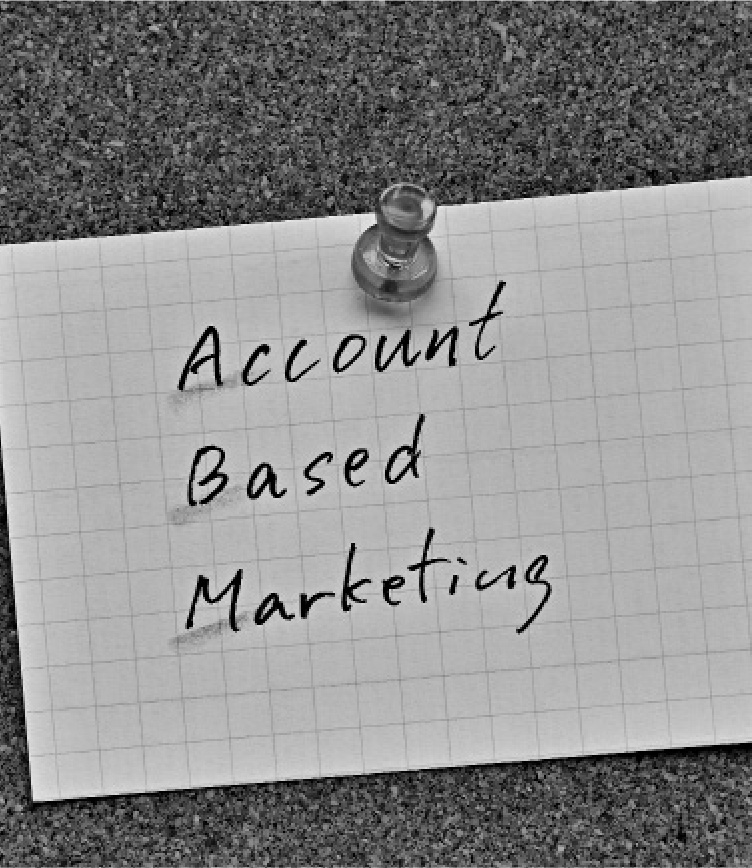
What is ABM, and where did it come from?
What is ABM, and where did it come from?
Account Based Marketing is a targeted approach to B2B marketing in which sales and marketing teams collaborate to target and convert best-fit accounts into customers.
ABM allows small marketing teams to land heavyweight client accounts through personalised messaging, making it feel like you've created content specifically for them.
Account Based Marketing is not a new concept. The term one-to-one marketing was first coined by two consultants, Don Peppers and Martha Rogers, in their 1993 book “The One to One Future.”
They made famous the concept of marketing to individuals rather than using a mass-market approach to marketing.
The strategy has become widely accepted since then, with about 84% of companies implementing ABM strategies recording a higher return on investment (ROI) than other marketing strategies.

Why ABM is perfect for B2B
Why ABM is perfect for B2B
Why ABM is perfect for B2B

Account Based Marketing is brilliantly suited for B2B marketing. For example, ABM yielded a higher ROI for 97% of B2B marketers than any other marketing strategy.
With Account Based Marketing, B2B brands can improve their ability to locate and delight the most qualified leads by basing their ideal customer profiles on existing customers.
Second, concentrating on huge accounts you are more confident of signing up produces many knock-on effects.
Despite your focus on the largest accounts, medium and small accounts with similar needs will discover your targeted marketing and sign up, especially if your website features an excellent customer list.
Why ABM is good for NFP
Why ABM is good for NFP
Why ABM is good for NFP

Even though Account Based Marketing appeals more to the B2B audience, mission-driven enterprises like NFP can also benefit from its focused approach to target best fit accounts. With Account Based Marketing, NFPs can also streamline their focus to specific accounts.
ABM also helps to create personalised messages that suit the non-profit narrative. Needless to say that personalisation is one of the factors that underpin customer experience and positive donor response. According to Campaign Monitor, donors and nonprofits seem to be aligned on content:

61.1%
of donors want to hear stories about organisations’ impact and how their services are helping. This is the content donors value most.

91.8%
of nonprofits believe this is the most important type of content for donors.
How ABM is different from Lead Generation?
How ABM is different from Lead Generation?
How ABM is different from Lead Generation?

ABM shares many similarities with lead generation strategies. However, the two concepts are different in the way they're implemented.
For example, ABM makes the most sense when a business targets high-touch, high-value enterprise accounts. On the other hand, lead generation is more suited to low-touch, lower-priced services aimed at a broader market.
While ABM qualifies prospects by defining the Ideal Customer Profiles (ICP) of target accounts, lead generation qualifies prospects by nurturing them through a sales funnel.
This means that ABM starts with the end goal - targeting key accounts - instead of qualifying leads via a sales funnel, thus turning the lead generation process upside down.
Why sales and marketing will love ABM
Why sales and marketing will love ABM
Why sales and marketing will love ABM

ABM shares many similarities with lead generation strategies. However, the two concepts are different in the way they're implemented.


Aside from your bottom line benefits, equipping your sales and marketing teams as best you can sets them up for success, and being successful at work is the easiest way to foster job satisfaction and enthusiasm, improving your organisation’s overall workplace morale.
Types of ABM
Types of ABM
Types of ABM
As your customer list grows, you will start noticing different patterns in your ABM accounts. This difference may be due to the ROI each account generates, which ultimately determines the attention you'll give and the extent of personalisation.
Therefore, categorising ABM accounts in tiers becomes necessary to help you create a more customised approach and maximise your limited resources. Here are the three types of ABM you should know about.

Let's take a closer look!
faceProgrammatic ABM (1:Many)
As the name (one-to-many) suggests, this tier focuses on shifting target accounts into much larger clusters and mass-customising campaigns for those accounts. This tier requires delivering a personalised message to a large number of accounts. Its effectiveness relies heavily on technology.
faceScale ABM (1:Few)
This tier is more targeted than the one-to-many tier because the level of customisation is more advanced. Here, programmes are designed for clusters of accounts with certain similarities. It is also easy to deploy these programmes since the issues apply to all accounts within the same cluster.
faceStrategic ABM (1:1)
The strategic ABM tier is reserved for the best of the best accounts and is mainly used to expand target accounts. It is executed one-to-one and the campaigns are highly personalised. In this type, the team focuses on cultivating connections with the essential stakeholders in their target accounts, especially when the possibilities of winning a contract are strong.
Please note that you can combine these types in any way/ratio of choice. It all depends on where you currently stand.

How to execute an ABM strategy in 9 easy(ish) steps

How to execute an ABM strategy in 9 easy(ish) steps
How to execute an ABM strategy in 9 easy(ish) steps
Does your brand need a revamp?
Mention this ebook for a special offer 30-minute brand consultation and audit FREE when we chat.
Let’s see where you stand!
How to measure ABM success
How to measure ABM success
How to measure ABM success
While having great ideas and executing them well is essential, it's also necessary to take a step back and define what a successful ABM strategy might look like in your company. Here’s how to measure the effectiveness of an ABM campaign:
Your primary goals and KPIs
Tracking progress by looking at page views, interaction, click-throughs, and additional metrics is quite important. But these are more specific to traditional lead generation. For ABM, you must see if you achieved your primary goals or met your top-level KPIs including quality account target, account contact growth, and revenue expansion within accounts.
More importantly, check if your team was able to establish quality account relationships and convert those relationships. At the end of the day, everything comes down to how well you can fill your pipeline, gain new customers, and meet your revenue targets.
The number of good-fit prospects at the accounts you engaged with
Focus on driving engagement within your target accounts
rather than customers’ online activities.
- Are phone calls being scheduled?
- Were there many downloads of your content?
- Have any of these targeted leads progressed
through the funnel? - Are there any stumbling blocks when it comes
to prospect engagement? - Are emails being read and responded to?
- Was there a satisfactory amount of social interaction?
These metrics are more important for a growth-minded ABM team than the traditional marketing metrics. Remember that the more engaged your prospects are, the more likely they are to buy, and ABM is a longer but more rewarding game than traditional B2B marketing.
Getting a good return on your investment
Having a positive ROI is, of course, a good way to
measure ABM's success. You must monitor target
account advancement across the whole buying journey to
appropriately quantify ABM success. With so much clarity
around sales, you can take a step back and assess the overall
impact of your efforts on your bottom line.
Furthermore, it would help if you considered how you could
do things better in the future. Have your sales and marketing
team discuss the high and low points of each campaign to
help them improve areas where improvement is needed.

You must monitor target account advancement across the whole buying journey to appropriately quantify ABM success.
Common ABM mistakes to avoid
Common ABM mistakes to avoid
 Common ABM mistakes to avoid
Common ABM mistakes to avoid
With ABM having lots of moving parts, there are bound to be mistakes, especially at the early stage of ABM implementation. These mistakes are inevitable, but some are avoidable. Let’s look at the most common mistakes marketing and sales teams make while executing ABM.
Lack of customer research
A fundamental mistake in ABM is getting started without doing proper research. For example, without defining your ideal customer profile, you won't know the type of companies you're targeting, their attributes and their pain points. Solid customer research is data-centric. Companies with a strong ICP achieve 68% higher account win rates.
Seeing it as a one-off campaign
Account Based Marketing is more of a strategy than a
campaign. It's not going to work if you try to run it like a sprint campaign. Instead, you need to embrace ABM as a long-term strategy that improves with time.
Limiting ABM to the marketing department
ABM is a coordinated effort between sales and marketing. It will only work if both departments work as one team since they will focus on the same accounts. They both should have common goals and harmonise their operations using a mutually benefitting workflow.
Over-relying on ABM tools
Investing in ABM Tools and platforms is a great idea. But these tools alone can’t solve all your problems. You still have to do your homework, such as analysing your target accounts, understanding your customers’ objectives, and laying the foundation for your ABM strategy. Some of these rely heavily on human involvement with a little touch of automation.
Rushing into ABM Implementation
ABM is a complex strategy to implement. Switching from your existing marketing strategy to full ABM without running a pilot project is a risky road with a high chance of failure. However, taking baby steps will allow you to iterate and optimise your process and gradually scale your efforts.
Lack of personalisation
Using generic messaging or vaguely addressing the general industry needs doesn’t cut it in ABM. The right approach is to create strategies that allow for personalised content that is highly relevant to your targeted accounts. It starts with understanding your ideal targets, identifying specific accounts within the organisations and understanding the personas behind these accounts. Missing these crucial steps will only prevent you from creating content or messaging that’s tailored to the accounts. You will also have difficulty addressing the challenges and delivering the perfect experience.
Tracking the wrong metrics
Judging your ABM campaigns using the same metrics as your traditional marketing campaigns is a big mistake. In conventional marketing, the standard metrics for measuring campaign success are clicks and conversions. However, in ABM, you’ll need to focus on your overall goals and KPIs, the most important being how many of the targeted accounts are being successfully closed.
Does your brand need a revamp?
Mention this ebook for a special offer 30-minute brand consultation and audit FREE when we chat.
Let’s see where you stand!
ABM Frequently Asked Questions
ABM Frequently Asked Questions
ABM Frequently Asked Questions
How do I shift my relationship from transactional to strategic?
Strategic ABM is the gold standard, as we've earlier stated. Shifting to strategic ABM requires developing valuable relationships and de-emphasising transactional activities. However, strategic ABM requires understanding your customer's goals and crafting your messaging around those goals.
To do that, follow the following steps:
- Recognise the high-value stakeholders who will help you sell more within a given account.
- Enhance your brand's profile by telling a compelling story that appeals to technical and economic customers.
- Share your account's plan with your stakeholders, and let them see the potential ROI through personalised online assets.
- Use competitive profiling to find strategies to unseat competitors and demonstrate the value you deliver to your stakeholders.
How do I drive advocacy to maximise revenue?
As much as you want to celebrate your wins internally and move on to the next promising account, you should also channel your energy to drive advocacy. You can drive advocacy by broadcasting your story while simultaneously driving adoption and usage. Follow these 4-step advocacy-plan to maximise revenue:
- Conduct a white-space analysis to determine who you know and who you need to know.
- To raise awareness among new, high-value stakeholders in your account, employ a combination of online (e.g. social media and online advertisement) and offline (e.g. networking and speaking engagements) initiatives to drive
use-case awareness. - Utilise micro-level retargeting in conjunction with geofenced and IP advertising to broadcast a range of important messages to educate decision-makers about your more significant propositions.
- Leverage marketing automation to offer highly customised experiences to your stakeholders while also gathering behavioural data for future ABM projects.
How do I upsell to an existing client?
Upsells are necessary not just for increasing a customer's average order value but for strengthening your customer relationship. Additionally, it is an opportunity to outwit your competitors by communicating your upsell offer in the most appropriate way to drive all stakeholders to action. Here's the three-step process involved:
- Make your competitors less relevant through laser-focused positioning.
- Find the right balance of physical, online, and sales enablement activities to engage customers, spark interest, and change perceptions.
- Demonstrate value to all stakeholders by sending highly tailored use case communications via the digital platforms they use frequently.
What can I do to support contract renewals?
Contract renewals are essential for businesses to thrive. Don’t rest on your laurels after winning a contract and hope the procurement team hands you a new contract on a platter. You need to earn the right of renewal by demonstrating value, mobilising end-users to support your business case, and overcoming any resistance. Here are the exact steps to take to make sure of this:
- Understand your decision-makers as well as their competitors. Know who you're dealing with, their issues and motives, and how to reach out to them.
- Use the correct tools, tactics, and messaging to demonstrate to your clients that you understand them and their business better than anybody else.
- Connect your use cases to your client's strategy and show you've done it previously. Then, back it up with an ROI model that demonstrates the impact on both the top and bottom lines.

We can say that account based marketing is the hottest marketing and client acquisition strategy in the B2B world right now. If you're looking to get higher value prospects and a substantial ROI increase from your campaigns, consider ABM.
To begin implementing ABM, you have to first lay the foundation of a successful ABM program by creating a winning ABM strategy, evaluating your technology infrastructure, launching a pilot program, and selecting the right ABM solution. With this taken care of, you're on the course to have a seamless ABM launch.
We can help you
Make It Happen is an independent full-service creative and marketing agency based in Sydney. We passionately help connect B2B and NFP organisations to their ideal audiences using industry leading marketing techniques.

